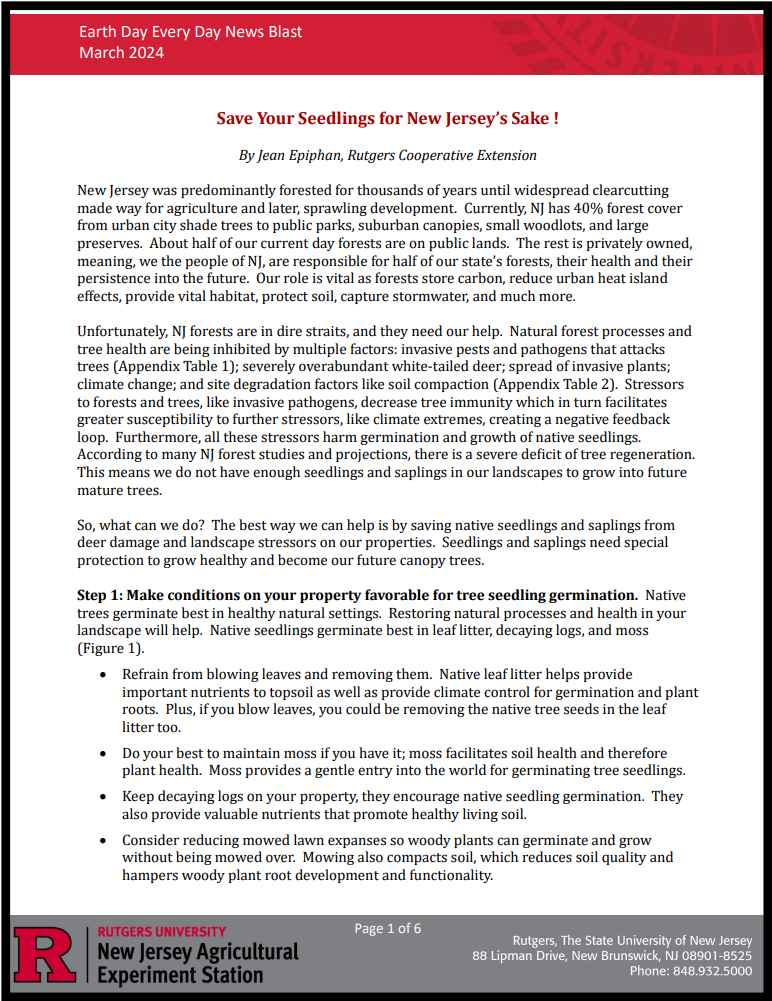Save Your Seedlings for New Jersey’s Sake!
ANREP Gold Award Winner
Outstanding Education Materials - Short Publication
Jean Epiphan, Rutgers University
The article begins with an explanation of forest loss over time and the current status of forested land ownership in New Jersey. The target audience is clearly identified as “we the people of NJ,’ as a plea for the main public to understand their responsibility in maintaining or restoring healthy trees and forest cover on their properties. Then the next introductory paragraph summarizes the current day main threats to forests. Invasive pests and pathogens as well as anthropogenetic stressors are further listed in supporting tables placed in an appendix at the end, to not detract from the main message. Due to forest threats and stressors, there are not enough seedlings and saplings in our landscapes to maintain healthy forests and canopy cover.
 Yet, instead of diving into the doom and gloom of current day forest health issues, this article explains the best way the main public can help, by promoting growth of seedlings and saplings. No popular article in New Jersey has even done this before. Next the article provides four novel steps to promoting seedling growth that are typically overlooked in standard landscape care and management. Step one addresses that status quo mowing and blowing eliminates native tree germination potential and degrades soil quality, which is not widely known. Step two provides the reasons why learning seedling identification is important, so one does not promote the growth of invasive tree species. It also offers registration for a free spring webinar on tree seedling identification. Step three takes the reader through the method of creating your own sturdy wire mesh barriers to protect seedlings and sapling from deer damage. Step four explains how to reduce common site stressors that harm soil health. This step teaches how restoring natural processes helps soil and seedlings become healthier and the importance of watering.
Yet, instead of diving into the doom and gloom of current day forest health issues, this article explains the best way the main public can help, by promoting growth of seedlings and saplings. No popular article in New Jersey has even done this before. Next the article provides four novel steps to promoting seedling growth that are typically overlooked in standard landscape care and management. Step one addresses that status quo mowing and blowing eliminates native tree germination potential and degrades soil quality, which is not widely known. Step two provides the reasons why learning seedling identification is important, so one does not promote the growth of invasive tree species. It also offers registration for a free spring webinar on tree seedling identification. Step three takes the reader through the method of creating your own sturdy wire mesh barriers to protect seedlings and sapling from deer damage. Step four explains how to reduce common site stressors that harm soil health. This step teaches how restoring natural processes helps soil and seedlings become healthier and the importance of watering.
The graphics and layout fit the Rutgers approved format for this newsletter. The figures provide visuals that support steps one through three. Figure 1 is a cleanly designed photo collage of native seedlings growing in natural settings to correspond to step one. Some of the seedlings are circled or have arrows pointing to them to demonstrate their location and size. Each have common and scientific names provided so readers can utilize them as a reference. Figure 2 corresponds to step two, “Learn how to identify tree seedling species.” This figure shows two look-alike species sugar maple and Norway maple, so landowners can easily learn their characteristics and quickly remove invasive Norway maples when it is easy to, right after germination. Figure 3 shows the damage buck rub can do next to an unharmed, properly protected sapling inside a wire mesh barrier, which is also the final product of step three.
This article was distributed to over 3500 readers of the Earth Day Every Day News Blast through email in March 2024. In the April following, 406 readers registered for the free Tree Seedlings Identification webinar and received a copy of the slides to utilize as a reference
guide for seedling identification. Following this article and webinar, New Jersey residents and stewardship groups utilized this methodology to promote germination, identify native tree seedlings, and protect them with wire mesh cages. In total, 636 tree seedlings have been identified and protected from deer damage. This will facilitate their healthy growth so they can become mature trees, provide long lasting ecological services, and be part of the future forest canopy of New Jersey.
Read the publication


 Yet, instead of diving into the doom and gloom of current day forest health issues, this article explains the best way the main public can help, by promoting growth of seedlings and saplings. No popular article in New Jersey has even done this before. Next the article provides four novel steps to promoting seedling growth that are typically overlooked in standard landscape care and management. Step one addresses that status quo mowing and blowing eliminates native tree germination potential and degrades soil quality, which is not widely known. Step two provides the reasons why learning seedling identification is important, so one does not promote the growth of invasive tree species. It also offers registration for a free spring webinar on tree seedling identification. Step three takes the reader through the method of creating your own sturdy wire mesh barriers to protect seedlings and sapling from deer damage. Step four explains how to reduce common site stressors that harm soil health. This step teaches how restoring natural processes helps soil and seedlings become healthier and the importance of watering.
Yet, instead of diving into the doom and gloom of current day forest health issues, this article explains the best way the main public can help, by promoting growth of seedlings and saplings. No popular article in New Jersey has even done this before. Next the article provides four novel steps to promoting seedling growth that are typically overlooked in standard landscape care and management. Step one addresses that status quo mowing and blowing eliminates native tree germination potential and degrades soil quality, which is not widely known. Step two provides the reasons why learning seedling identification is important, so one does not promote the growth of invasive tree species. It also offers registration for a free spring webinar on tree seedling identification. Step three takes the reader through the method of creating your own sturdy wire mesh barriers to protect seedlings and sapling from deer damage. Step four explains how to reduce common site stressors that harm soil health. This step teaches how restoring natural processes helps soil and seedlings become healthier and the importance of watering.